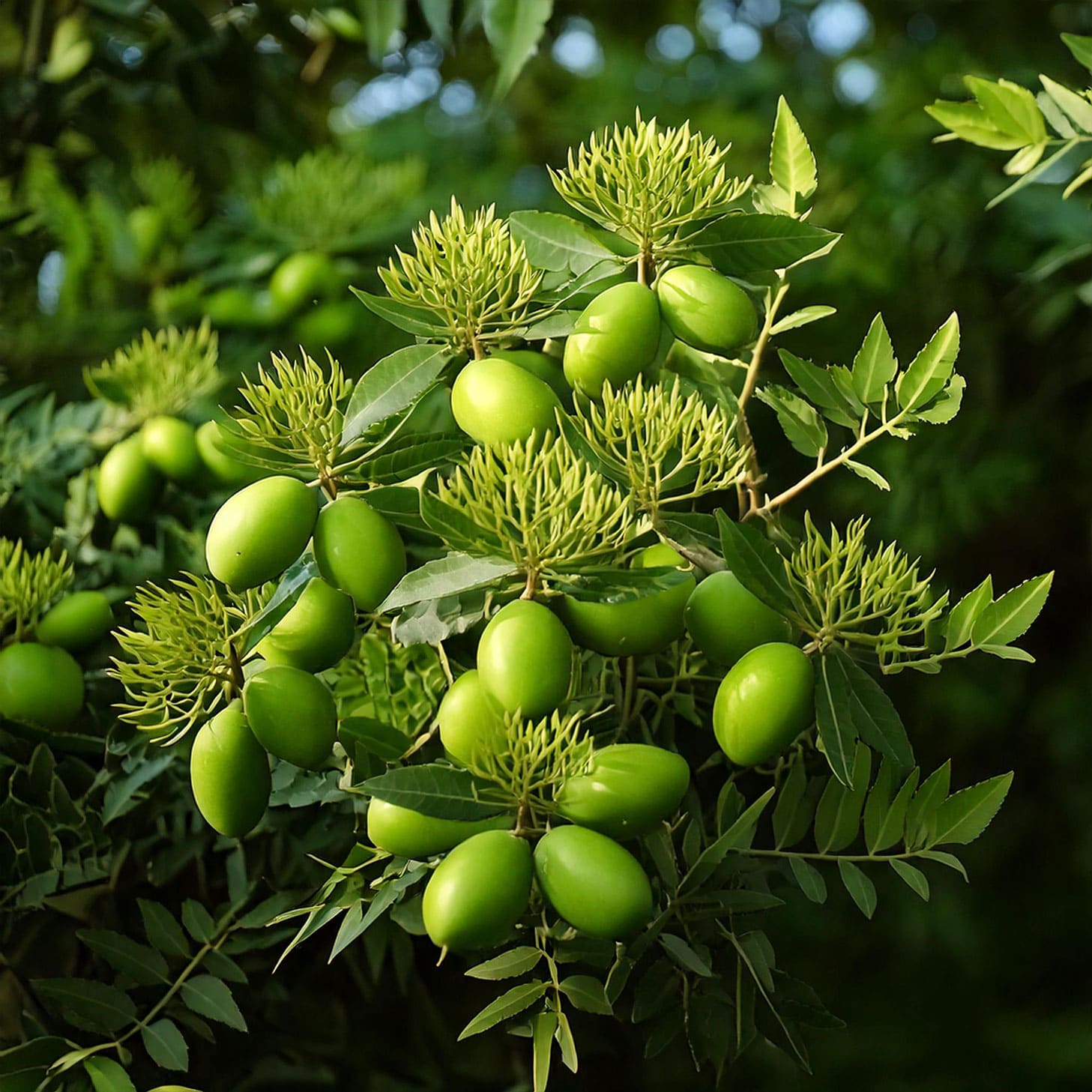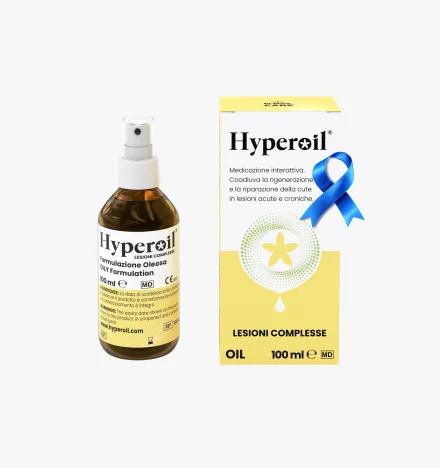Neem
THE TREE WITH EXTRAORDINARY PROPERTIES
Neem (Azadirachta indica) is an evergreen tree native to India and other parts of the Indian subcontinent with great therapeutic properties.

NAME
Neem - Azadirachta indica
FAMILY
Meliacee
WHERE IT IS USED
medicine, cooking, agriculture
Neem plant and derivatives
PROPERTIES AND BENEFITS
Antibacterial and antiviral properties
effective against different types of infections due to its ability to fight bacteria, viruses and fungi.
Anti-inflammatory properties
Useful in joint pain, arthritis and other inflammatory conditions.

Healing properties
Hydrates and regenerates the skin, ideal for wounds and burns.
Detoxifying and purifying
Supports liver health and promotes the removal of toxins from the body.

Curiosities
Not only is this tree a powerful healing element for aches, fevers and infections, it is also a symbol of self-sufficiency for many rural Indian communities, offering health solutions directly from its natural environment.
Index
What is Neem: the tree
Neem, scientifically known as Azadirachta indica, is an evergreen tree that is a member of the Meliaceae family. Native to Indiaand Burma, it is also widespread in other Asian regions such as Bangladesh, Cambodia, Laos, Thailand and Vietnam.
Reaching 25 meters in height and with a longevity that can extend up to 300 years, Neem is distinguished by its ability to adapt to poor soils and arid climates, making it exceptionally resilient. Neem's deep roots allow it to draw water even in drought conditions to support rapid growth: the tree can, in fact, reach 7 meters in height in just three years.
In addition to being a bulwark against desertification, Neem is valuable for cooling urban areas. Its dense foliage not only provides protective shade but also helps reduce temperature making it a key element in urban reforestation strategies, where it helps moderate city climate, improve air quality by absorbing CO₂ and filter water with its roots.
Botanically, Neem seeds are particularly rich in limonoids, substances known to be effective for their biological properties. Among the main active compounds are Azadirachtin and Salannin, which are studied for their applications in areas such as organic farming and alternative medicine, making Neem a focus of interest for scientific research.
In addition, Neem has been proclaimed "Tree of the 21st Century" by the United Nations for its positive environmental and health impacts. Every part of the tree, from the bark to the leaves, is exploited for its healing virtues, confirming its Sanskrit name, Sarva roga nidarini, which means "the healer of all ailments." With its wide use and beneficial properties, Neem continues to be an irreplaceable ally for human health and environmental sustainability.
History of the Neem Tree
The use of Neem has deep roots in Ayurvedic tradition, having been revered for millennia as a mainstay of natural medicine. Ancient Sanskrit texts reveal that every part of the tree-from leaves to bark, flowers to fruit, roots to wood-is rich in substances with medicinal properties.
In India, Neem was affectionately nicknamed "the village pharmacy," a tribute to its wide range of health applications. For centuries, local people have used this tree as a remedy for multiple ailments:
- the twigs are chewed for dental care,
- the juice extracted from the leaves is used to treat skin problems,
- infusions of its parts are consumed as health tonics.
With such a rich history, Neem continues to be an essential component in contemporary Ayurvedic culture and practice.
Properties
Neem Oil, which is obtained from the tree, is a potent extract rich in bioactive ingredients, recognized for its many beneficial properties that find application in various fields, such as medicinal, cosmetic, agricultural and veterinary:
- Antiparasitic action: the presence of Azadirachtin, the main active ingredient in Neem Oil, makes it an excellent antiparasitic for plants, animals and humans. Neem Oil is particularly effective against lice infestations, capable of eliminating even the eggs, making it a preferred treatment for hair and scalp care.
- Antibacterial and antifungal action: Neem Oil possesses antibacterial and fungicidal properties, proving effective in treating infections such as candidiasis and viral infections such as herpes, offering a natural alternative to conventional treatments.
- Anti-inflammatory action: for those suffering from skin conditions such as dermatitis or psoriasis, Neem Oil offers significant relief due to its anti-inflammatory properties. It is also used to relieve pain and inflammation associated with muscle problems, such as strains and contractures.
- Antipyretic action: Neem Oil helps reduce fever by acting on body temperature regulatory mechanisms.
- Anti-seborrheic action: effective in controlling itching and excessive sebum production, helping to keep the scalp and skin in balance.
- Moisturizing and healing properties: rich in essential fatty acids (polyunsaturated and monounsaturated), phenolic and sulfur compounds, Neem Oil moisturizes, protects and regenerates the skin. It reduces irritation and scaling of wounds, proving useful in extensive burns, infected wounds, and to stimulate tissue reconstruction and healing.
Because of these properties, Neem Oil continues to be a valuable ingredient, respected in both traditional and modern medicine for its wide range of beneficial applications.
Use
Available in different forms such as oil, powder, capsules and infusions, Neem Oil is widely used for:
- Dermatological treatments: paste made from Neem bark and leaves is extremely effective in treating skin disorders such as eczema, psoriasis and small wounds. This use is based on the tree's anti-inflammatory and repairing properties.
- Digestive benefits: Neem leaves, after being boiled for a long time, produce a bitter infusion that is very effective in treating intestinal infections and episodes of diarrhea. Their antibacterial and purifying action supports the health of the digestive system.
- Aromatherapy: essential oil extracted from Neem Flowers is known for its calming and relaxing effects, making it a popular ingredient in aromatherapy to relieve stress and anxiety.
- Oral hygiene: chewing a sprig of Neem is a traditional method of activating its natural antiseptic properties. Rubbing the frayed sprig on gums and teeth makes an organic toothbrush that contributes to oral health by preventing infection and gum disease.
Other uses
In addition to its well-known therapeutic and medicinal benefits, Neem also finds extensive application in other areas. For example, it is particularly valued in organic farming for its insecticidal properties. It functions as a powerful repellent against a wide variety of pests and insect pests, but has the advantage of being non-toxic to humans and animals. This makes it an ideal ecological alternative to chemical pesticides, helping to maintain a healthy and sustainable agricultural ecosystem.
Its action is enhanced in products such as those in the Hyperoil® line of RI.MOS. CARE, which includes medical devices in oily and gel formulations. These products create a protective barrier that facilitates tissue regeneration and repair in acute and chronic injuries that resolve by second intention.
You may not have known that…
Its antibacterial and antiparasitic properties also find application in veterinary treatment to combat flea and tick infestations.
The use of Neem in these contexts demonstrates its versatility and the added value it can offer in both agriculture and daily animal care, solidifying its role as a valuable natural resource for a variety of practical needs.
Contraindications
Neem is generally recognized as safe for most uses, but it is essential to take precautions to avoid unwanted effects.
In fact, misuse or excessive intake of Neem Oil may cause some side effects such as skin irritation or gastrointestinal disorders. It is, therefore, important to follow the dosage directions and recommended methods of use.
Before supplementing Neem Oil, it is important to consider possible drug interactions, especially if you are taking blood thinners or hormonal contraceptives. Consulting a healthcare professional is always recommended to avoid complications; in fact, it is also not recommended for women who are pregnant, conceiving, or breastfeeding.
Products with Neem
Neem is one of the main components of the Hyperoil® line, designed to protect injured tissues and promote their repair processes through its natural properties.
Subscribe to our newsletter and get 10% off!
Stay up to date with the latest news, promotions, and exclusive offers from RI.MOS. CARE.

Do you have a question?
Our team of experts has an answer for you!
What is the difference between tissue regeneration and repair?
In case of injury, the physiological reflex of the organism and thus of the tissues is to evolve toward a regenerative and/or reparative process.
The difference between these two mechanisms is:
- Regeneration:
damaged tissues are replaced with cells of the same type. - Repair:
damaged tissues are replaced with connective tissue (fibrosis).
Why is the use of topical steroidal anti-inflammatory drugs (cortisone ointments) not recommended to treat an injury?
Steroidal anti-inflammatory drugs cause the scarring process to stop, torpid sores, promoting the development of bacterial and fungal infections.
Why is the use of disinfectants not recommended to treat an injury?
Disinfectants (based on iodine, chlorine, oxygen peroxide, etc.) are known to be histolesive. Used to ward off infection risks, they themselves become detrimental to tissue repair, being very potent inhibitors of cell proliferation, both of fibroblasts and keratinocytes.
The use of disinfectants, depending on the stage of the injury, causes these effects:
- re-initiation of the inflammatory process;
- pathological prolongation of the inflammatory phase;
- failure to progress to the granulation stage;
- stopping the granulation phase;
- inhibition of re-epithelialization;
- scar fibrotization (poor quality scarring).
What are the stages of wound healing?
There are three stages of wound healing:
- Stage 1: exudative or inflammatory or also called cleansing stage
- Stage 2: granulation or proliferative phase (granulation tissue formation)
- Stage 3: epithelialization or regenerative phase (scar formation and epithelialization)
What does "primary dressing" mean?
A primary dressing is one that is placed in direct contact with the injured tissues and interacts with the physiological processes of the injury.
What does "secondary dressing" mean?
A secondary dressing does not interact with the wound, but serves to:
- fill a cavity to absorb excess exudate and maintain the primary dressing over the wound;
- cover a wound to protect it while absorbing excess exudate and maintaining the primary dressing on the wound;
- Fix other secondary dressings and/or the primary dressing on the site of the injury.


